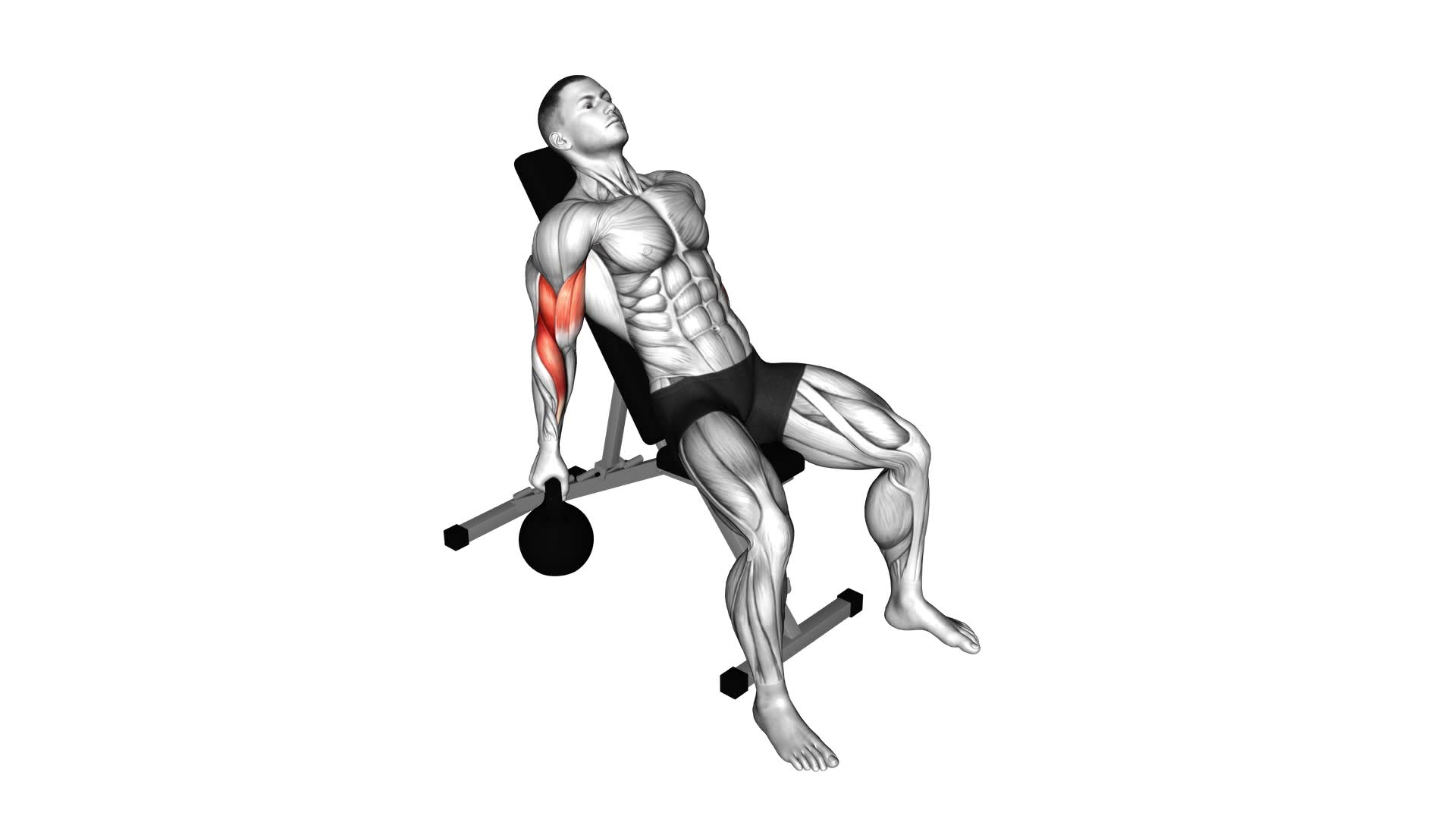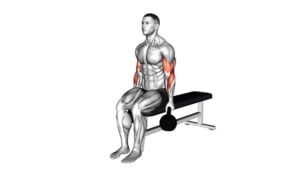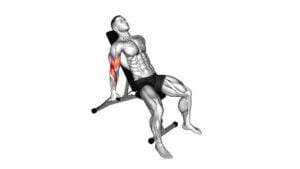Kettlebell Incline Alternate Curl – Video Exercise Guide & Tips

Looking to tone your biceps and build upper body strength? The kettlebell incline alternate curl is the exercise for you.
Watch This Exercise Video
In this video exercise guide, we'll show you the proper form and technique, along with essential tips to maximize your results.
No need to worry about complicated equipment – all you need is a kettlebell.
Get ready to feel the burn as we guide you through step-by-step instructions and provide helpful modifications for beginners.
Let's get those guns pumping!
Key Takeaways
- Follow step-by-step instructions for proper form and technique
- Choose appropriate equipment and modify as needed for individual preferences and goals
- Avoid common mistakes such as using too heavy of a weight or swinging the kettlebell
- Start with lighter weights and gradually increase difficulty, seeking professional guidance if needed
Proper Form and Technique
To perform the Kettlebell Incline Alternate Curl with proper form and technique, you should always carefully and consistently follow the step-by-step instructions provided in the video guide. It's important to avoid common errors that can compromise your results and increase the risk of injury.
One common error is using too much momentum when lifting the kettlebell. Instead, focus on controlled movements and engage your biceps to lift the weight. This ensures proper muscle activation and maximizes the effectiveness of the exercise.
Another mistake to avoid is arching your back or using your shoulders to lift the kettlebell. This can lead to strain and discomfort in these areas. Instead, maintain a stable and neutral spine position throughout the movement. Keep your core engaged and focus on using your biceps to lift the weight.
To further enhance muscle activation, make sure to fully extend your arm during the curl. This helps to engage the entire bicep muscle and maximize its growth potential. Additionally, maintain a steady breathing pattern and avoid holding your breath during the exercise.
Equipment Needed
To perform the Kettlebell Incline Alternate Curl, you'll need a kettlebell and an incline bench. The kettlebell is essential for providing resistance and targeting your biceps, while the incline bench allows you to perform the exercise at an angle, engaging your muscles in a different way.
If you don't have access to an incline bench, you can modify the exercise by using a stability ball or simply standing with a slight forward lean.
Essential Equipment for Incline
What equipment do you need for the incline exercise?
When performing the kettlebell incline alternate curl, there are a few essential pieces of equipment that you'll need.
First and foremost, you'll need a kettlebell of an appropriate weight. The weight selection is crucial because using a weight that's too heavy can lead to injury, while using a weight that's too light may not provide enough resistance for an effective workout. It's important to choose a weight that challenges you without compromising your form or safety.
Additionally, you'll need an incline bench or an adjustable bench set at an incline. This will allow you to perform the exercise with the correct form and target the muscles effectively.
Now, let's explore alternative equipment options for the incline exercise.
Alternative Equipment Options
You will need specific equipment to perform the kettlebell incline alternate curl exercise. However, if you don't have access to a kettlebell, there are alternative equipment options that you can use to achieve similar benefits.
One alternative is using dumbbells instead of kettlebells. Dumbbells offer a similar range of motion and can target the same muscle groups.
Another option is using resistance bands. They're portable, affordable, and provide variable resistance.
Comparing the effectiveness of different equipment options, it largely depends on personal preference and individual goals. Both dumbbells and resistance bands can be effective alternatives to kettlebells for the incline alternate curl exercise.
Ultimately, the choice of equipment should be based on what feels comfortable and allows you to perform the exercise safely and effectively.
Step-by-Step Instructions
To perform the Kettlebell Incline Alternate Curl exercise, start by lying down on an incline bench with a kettlebell in each hand. Follow these step-by-step instructions for proper execution:
- Position yourself on the incline bench with your feet firmly planted on the floor and your back flat against the bench.
- Hold a kettlebell in each hand, palms facing forward, with your arms fully extended towards the floor.
- Slowly curl one kettlebell towards your shoulder while keeping your elbow close to your body and your back against the bench.
- Lower the kettlebell back down to the starting position and repeat the movement with the opposite arm.
- Continue alternating curls between each arm for the desired number of repetitions.
Modifications for beginners:
- Start with lighter kettlebells to build strength and proper form.
- Perform the exercise on a flat bench instead of an incline bench to reduce the level of difficulty.
- If necessary, perform the exercise without any weights until you feel comfortable enough to add resistance.
Common Mistakes to Avoid
To prevent common mistakes, ensure proper form and technique when performing the kettlebell incline alternate curl.
One common mistake to avoid is using too heavy of a weight. It's important to start with a weight that allows you to maintain proper form throughout the exercise. Using a weight that's too heavy can lead to improper technique, which increases the risk of injury.
Another common mistake is swinging the kettlebell. Remember to keep your movements controlled and avoid using momentum to lift the weight. This will ensure that you're effectively targeting the muscles and reducing the risk of strain or injury.
Additionally, it's important to maintain a neutral spine throughout the exercise. Avoid arching your back or hunching your shoulders as this can put unnecessary strain on your spine and compromise your form.
Tips for Increasing Difficulty
To increase the difficulty of the kettlebell incline alternate curl, incorporate heavier weights into your routine. Gradually increase the weight of the kettlebell you use for the incline alternate curl. This will put more strain on your muscles and encourage growth and strength development.
Another option is to slow down the tempo of each repetition. Instead of performing the exercise at a regular pace, slow down the tempo. This will increase time under tension and make the exercise more challenging.
You can also try increasing the number of repetitions you perform for each set. Instead of sticking to a specific rep range, perform more reps. This will help build muscular endurance and increase the overall difficulty of the exercise.
Incorporating pauses at different points during the exercise can also be effective. For example, you could pause at the top of the curl or halfway through the movement. This will further engage your muscles and make the exercise more demanding.
Modifications for Beginners
If you're new to the kettlebell incline alternate curl, here are some modifications to help you get started. These beginner modifications will make the exercise more manageable and allow you to build strength gradually.
First, you can start by using a lighter kettlebell or even a dumbbell instead. This will reduce the resistance and make it easier for you to perform the exercise correctly. As you become more comfortable and confident, you can gradually increase the weight of the kettlebell.
Another modification you can make is to perform the exercise without the incline. Instead of lying on an incline bench, you can simply stand or sit on a flat surface. This reduces the intensity of the exercise and makes it more beginner friendly.
Additionally, you can focus on mastering the technique before adding any weight. Practice the movement without any weight first, ensuring that you have the proper form and range of motion. Once you feel comfortable, you can then start adding weight gradually.
Frequently Asked Questions
How Many Repetitions Should I Aim for When Performing the Kettlebell Incline Alternate Curl?
When performing the kettlebell incline alternate curl, it's important to focus on the ideal repetition range.
The number of repetitions you should aim for depends on your fitness level and goals. Generally, it's recommended to perform 8-12 repetitions per set. However, you can also vary the number of repetitions to challenge your muscles in different ways.
Experiment with different variations of the kettlebell incline curl to keep your workouts interesting and effective.
Can I Use Dumbbells Instead of Kettlebells for This Exercise?
Yes, you can use dumbbells instead of kettlebells for the incline alternate curl exercise. Both kettlebells and dumbbells provide benefits for this exercise.
The incline position targets your biceps and helps to isolate the muscle group. However, using dumbbells allows for greater range of motion and provides a different grip variation.
Is It Necessary to Warm up Before Performing the Kettlebell Incline Alternate Curl?
Before performing the kettlebell incline alternate curl, it's important to warm up. Warming up has many benefits, such as increasing blood flow to your muscles and preparing your body for exercise.
To properly warm up, you can start with some light cardio exercises like jogging or jumping jacks. Then, you can do dynamic stretches that target the muscles you'll be using during the exercise. This will help prevent injuries and improve your performance.
What Muscles Does the Kettlebell Incline Alternate Curl Target?
The kettlebell incline alternate curl is a great exercise for targeting your biceps and upper body strength. Incline exercises like this have several benefits, including increased muscle activation and improved range of motion.
There are also variations of bicep curls that use different equipment, such as dumbbells or resistance bands. Incorporating these exercises into your routine can help you build stronger and more defined biceps while working your upper body muscles.
How Often Should I Incorporate the Kettlebell Incline Alternate Curl Into My Workout Routine?
To optimize your workout routine, it's important to consider the optimal frequency for incorporating the kettlebell incline alternate curl. This exercise targets your biceps, forearms, and shoulders.
For effective muscle targeting, you can try variations of this exercise, such as increasing the weight or incorporating different grips. However, it's crucial to listen to your body and avoid overtraining.
Aim to include this exercise 2-3 times a week for optimal results.
Conclusion
In conclusion, the kettlebell incline alternate curl is an effective exercise for targeting the biceps and building upper body strength.
By following the proper form and technique, using the necessary equipment, and avoiding common mistakes, you can maximize the benefits of this exercise.
Additionally, tips for increasing difficulty and modifications for beginners ensure that this exercise can be tailored to individual fitness levels.
Incorporate the kettlebell incline alternate curl into your workout routine for stronger, more defined arms.

Author
Years ago, the spark of my life’s passion ignited in my mind the moment I stepped into the local gym for the first time. The inaugural bead of perspiration, the initial endeavor, the very first surge of endorphins, and a sense of pride that washed over me post-workout marked the beginning of my deep-seated interest in strength sports, fitness, and sports nutrition. This very curiosity blossomed rapidly into a profound fascination, propelling me to earn a Master’s degree in Physical Education from the Academy of Physical Education in Krakow, followed by a Sports Manager diploma from the Jagiellonian University. My journey of growth led me to gain more specialized qualifications, such as being a certified personal trainer with a focus on sports dietetics, a lifeguard, and an instructor for wellness and corrective gymnastics. Theoretical knowledge paired seamlessly with practical experience, reinforcing my belief that the transformation of individuals under my guidance was also a reflection of my personal growth. This belief holds true even today. Each day, I strive to push the boundaries and explore new realms. These realms gently elevate me to greater heights. The unique combination of passion for my field and the continuous quest for growth fuels my drive to break new ground.







